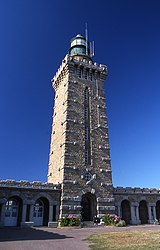Phare du Cap Fréhel
| Phare du Cap Fréhel | ||
|---|---|---|
| Entrance to the Phare du Cap Fréhel | ||
| Place: | Plévenon , France | |
| Location: | Cotes-d'Armor , Brittany , France | |
| Geographical location: | 48 ° 41 ′ 3 " N , 2 ° 19 ′ 8" W | |
| Height of tower base: | 52.15 m | |
| Fire carrier height : | 32.85 m | |
| Fire height : | 85 m | |
|
|
||
| Identifier : | 2 groups of white flashes in 12 seconds | |
| Scope knows: | 29 nm (53.7 km ) | |
| Optics: | Halides 1000 W | |
| Function: | Orientation fire | |
| Operating time: | 1950 | |
Phare du Cap Fréhel is the name of a lighthouse that was built between 1946 and 1950 on the Fréhel point in the Côtes-d'Armor department in Brittany . Its range is theoretically 29 nautical miles which corresponds to about 55 kilometers. It illuminates the extremely dangerous crossing from Saint-Brieuc to Saint-Malo and replaced an older tower that was blown up in World War II , which in turn was the successor to the still existing tower from the era of fortress builder Vauban .
The lighthouse has been listed as a historic monument of France since May 23, 2011 and is open to the public during the summer months.
First lighthouse ( Phare Vauban )
In May 1694 General Vauban inspected the north coast of Brittany and suggested building a tower on Cap Fréhel to warn of attacks by the English fleet. The general commissioner of the fortifications under Louis XIV had already implemented such structures with the Stiff lighthouse on the island of Ouessant , the Phare des Baleines on the island of Île de Ré and the Phare de Chassiron on the island of Île d'Oléron .
Built by Siméon Garangeau according to the plans of the Stiff lighthouse, the first 15-meter-high cylindrical lighthouse began its service in 1702. The stone-walled tower was crowned with a half cylinder, which housed the lighting. Until 1717, this was only in operation in the winter months. Until 1774 the light came from an open fire that was fed with charcoal, after which round lamps that were operated with vegetable oil were used. Since the tower was re-equipped with eight parabolic mirrors in 1821 and the beacon became rotatable, it gave off a long blink every 135 seconds. The range of the lights was 21 nautical miles .
Second lighthouse
From 1840, due to the poor condition of the building, Léonce Reynaud designed a new octagonal tower with a height of 22 meters and a Fresnel lens . The range was increased to 25 nautical miles. This new lighthouse cost 85,000 francs and was inaugurated on May 1, 1847. The plans dating from 1880 to electrify the tower in 1880 were rejected by the ministry on July 23, 1886. During the Second World War, the tower served the German occupation forces as a surveillance tower for the Atlantic. When they withdrew, the Wehrmacht blew up the building on August 11, 1944. The old Phare Vauban remained and served as a provisional facility until 1950 .
Today's lighthouse
Construction of today's lighthouse began in 1946. The architect Yves Hémar was responsible. On July 1, 1950, the almost 33 meter high brick tower with a square floor plan, which is symmetrically flanked by a U-shaped building ensemble, was inaugurated. The system is completely electrified.
gallery
See also
Individual evidence
- ↑ Entry no. PA22000032 in the Base Mérimée of the French Ministry of Culture (French)






